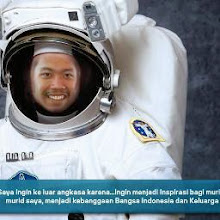Superstring Theory
By:
Arip Nurahman
Department of Physics
Faculty of Sciences and Mathematics, Indonesia University of Education
and
Follower Open Course Ware at Massachusetts Institute of Technology
Cambridge, USA
Department of Physics
http://web.mit.edu/physics/
http://ocw.mit.edu/OcwWeb/Physics/index.htm
&
Aeronautics and Astronautics Engineering
http://web.mit.edu/aeroastro/www/
http://ocw.mit.edu/OcwWeb/Aeronautics-and-Astronautics/index.htm
Arip Nurahman
Department of Physics
Faculty of Sciences and Mathematics, Indonesia University of Education
and
Follower Open Course Ware at Massachusetts Institute of Technology
Cambridge, USA
Department of Physics
http://web.mit.edu/physics/
http://ocw.mit.edu/OcwWeb/Physics/index.htm
&
Aeronautics and Astronautics Engineering
http://web.mit.edu/aeroastro/www/
http://ocw.mit.edu/OcwWeb/Aeronautics-and-Astronautics/index.htm


Basics
So what is string theory? For that matter, what the heck are elementary particles? If this all sounds totally confusing, try this section first.
| Experiment What progress are physicists making towards experimental tests of string theory predictions? | Mathematics What kinds of math do string theorists use and why? And how has string theory changed mathematics? |
| Black Holes Personal safety issues aside, when black holes are tied up in strings, they get even more interesting. | Cosmology Was there a String Bang before the Big Bang, or did the Universe simply unwind? |
| History Find out how string theory outlasted the Vietnam War, Mrs. Thatcher and grunge music, in our Timeline section | People So who are the people who work on string theory? Check them out in our People section. |
| Links Send us email! Sign our guestbook! Here are a few links to our sympathizers, co-marketers and even the competition. | Theatre Now playing in the String Theatre: a Real Audio physics colloquium by Prof. John Schwarz. |
| Bookstore Looking for books on string theory or other topics in modern theoretical physics? | Forum Discuss string theory and the legacy of Albert Einstein in our community forum. |
Abstract
Superstring theory is an attempt to explain all of the particles and fundamental forces of nature in one theory by modelling them as vibrations of tiny supersymmetric strings. It is considered one of the most promising candidate theories of quantum gravity. Superstring theory is a shorthand for supersymmetric string theory because unlike bosonic string theory, it is the version of string theory that incorporates fermions and supersymmetry.
Background
The deepest problem in theoretical physics is harmonizing the theory of general relativity, which describes gravitation and applies to large-scale structures (stars, galaxies, super clusters), with quantum mechanics, which describes the other three fundamental forces acting on the atomic scale.
The development of a quantum field theory of a force invariably results in infinite (and therefore useless) probabilities. Physicists have developed mathematical techniques (renormalization) to eliminate these infinities which work for three of the four fundamental forces – electromagnetic, strong nuclear and weak nuclear forces - but not for gravity. The development of a quantum theory of gravity must therefore come about by different means than those used for the other forces.
Basic idea
The basic idea is that the fundamental constituents of reality are strings of the Planck length (about 10−33 cm) which vibrate at resonant frequencies. Every string in theory has a unique resonance, or harmonic. Different harmonics determine different fundamental forces. The tension in a string is on the order of the Planck force (1044 newtons). The graviton (the proposed messenger particle of the gravitational force), for example, is predicted by the theory to be a string with wave amplitude zero. Another key insight provided by the theory is that no measurable differences can be detected between strings that wrap around dimensions smaller than themselves and those that move along larger dimensions (i.e., effects in a dimension of size R equal those whose size is 1/R). Singularities are avoided because the observed consequences of "Big Crunches" never reach zero size. In fact, should the universe begin a "big crunch" sort of process, string theory dictates that the universe could never be smaller than the size of a string, at which point it would actually begin expanding.
| String theory | |||||
Superstring theory
| |||||

Extra dimensions
- See also: Why does consistency require 10 dimensions?
Our minds have difficulty visualizing higher dimensions because we can only move in three spatial dimensions. One way of dealing with this limitation is not to try to visualize higher dimensions at all, but just to think of them as extra numbers in the equations that describe the way the world works. This opens the question of whether these 'extra numbers' can be investigated directly in any experiment (which must show different results in 1, 2, or 2+1 dimensions to a human scientist). This, in turn, raises the question of whether models that rely on such abstract modelling (and potentially impossibly huge experimental apparatus) can be considered scientific. Six-dimensional Calabi-Yau shapes can account for the additional dimensions required by superstring theory. The theory states that every point in space (or whatever we had previously considered a point) is in fact a very small manifold where each extra dimension has a size on the order of the Planck length.
Superstring theory is not the first theory to propose extra spatial dimensions; the Kaluza-Klein theory had done so previously. Modern string theory relies on the mathematics of folds, knots, and topology, which were largely developed after Kaluza and Klein, and has made physical theories relying on extra dimensions much more credible.
Unsolved problems in physics: Is string theory, superstring theory, or M-theory, or some other variant on this theme, a step on the road to a "theory of everything," or just a blind alley?
References
- ^ M. J. Duff, James T. Liu and R. Minasian Eleven Dimensional Origin of String/String Duality: A One Loop Test Center for Theoretical Physics, Department of Physics, Texas A&M University
- ^ Polchinski, Joseph (1998). String Theory, Cambridge University Press.
- ^ a b H. Nastase The RHIC fireball as a dual black hole BROWN-HET-1439, ArXiv: hep-th/0501068, January 2005,
- ^ a b H. Nastase More on the RHIC fireball and dual black holes BROWN-HET-1466, ArXiv: hep-th/0603176, March 2006,
- ^ a b H. Liu, K. Rajagopal, U. A. Wiedemann An AdS/CFT Calculation of Screening in a Hot Wind, MIT-CTP-3757, July 2006,
- ^ a b H. Liu, K. Rajagopal, U. A. Wiedemann Calculating the Jet Quenching Parameter from AdS/CFT, Phys.Rev.Lett.97:182301,2006
- ^ To compare, the size of an atom is roughly 10-10 m and the size of a proton is 10-15 m. To imagine the Planck length: you can stretch along the diameter of an atom the same number of strings as the number of atoms you can line up to Proxima Centauri (the nearest star to Earth after the Sun). The tension of a string (8.9×1042 newtons) is about 1041 times the tension of an average piano string (735 newtons).
- ^ S. James Gates, Jr., Ph.D., Superstring Theory: The DNA of Reality "Lecture 23 - Can I Have that Extra Dimension in the Window?", 0:04:54, 0:21:00.
- ^ Simeon Hellerman, Ian Swanson: "Dimension-changing exact solutions of string theory". e-Print: hep-th/0612051; Ofer Aharony, Eva Silverstein: "Supercritical stability, transitions and (pseudo)tachyons". Physical Review D 75:046003, 2007. e-Print: hep-th/0612031
- ^ The calculation of the number of dimensions can be circumvented by adding a degree of freedom which compensates for the "missing" quantum fluctuations. However, this degree of freedom behaves similar to spacetime dimensions only in some aspects, and the produced theory is not Lorentz invariant, and has other characteristics which don't appear in nature. This is known as the linear dilaton or non-critical string.
- ^ "Quantum Geometry of Bosonic Strings – Revisited"
- ^ Aharony, O.; S.S. Gubser, J. Maldacena, H. Ooguri, Y. Oz (2000). "Large N Field Theories, String Theory and Gravity" (subscription required). Phys. Rept. 323: 183–386. doi:. http://arxiv.org/abs/hep-th/9905111.. For other examples see: [1]
- ^ For example: T. Sakai and S. Sugimoto, Low energy hadron physics in holographic QCD, Prog.Theor.Phys.113:843-882,2005, ArXiv: hep-th/0412141, December 2004
- ^ See for example Recent Results of the MILC research program, taken from the MILC Collaboration homepage
- ^ David Gross, Perspectives, String Theory: Achievements and Perspectives - A conference
- ^ M. R. Douglas,Are There Testable Predictions of String Theory? February 2007 Texas A&M
- ^ a b Peter Woit's Not Even Wrong weblog
- ^ a b Lee Smolin's The Trouble With Physics webpage
- ^ John Baez and responses on the group weblog The n-Category Cafe
- ^ John Baez weblog
- ^ Unstrung: The New Yorker
- ^ See e.g. E. Kiritsis, String theory in a nutshell. Introduction to Modern String theory, Princeton University Press, Princeton, N.Y. (2007)
- ^ a b c S. Kachru, R. Kallosh, A. Linde and S. P. Trivedi, de Sitter Vacua in String Theory, Phys.Rev.D68:046005,2003
- ^ P. Woit (Columbia University) String theory: An Evaluation,February 2001, e-Print: physics/0102051
- ^ P. Woit, Is String Theory Testable? INFN Rome March 2007
- ^ Prominent critics include Philip Anderson ("string theory is the first science in hundreds of years to be pursued in pre-Baconian fashion, without any adequate experimental guidance", New York Times, 4 January 2005), Sheldon Glashow ("there ain't no experiment that could be done nor is there any observation that could be made that would say, `You guys are wrong.' The theory is safe, permanently safe", NOVA interview), Lawrence Krauss ("String theory [is] yet to have any real successes in explaining or predicting anything measurable", New York Times, 8 November 2005), Peter Woit (see his blog, article and book "Not Even Wrong", ISBN 0-224-07605-1) and Carlo Rovelli (see his Dialog on Quantum Gravity)
- ^ N. Arkani-Hamed, S. Dimopoulos and S. Kachru, Predictive Landscapes and New Physics at a TeV, SLAC-PUB-10928, HUTP-05-A0001, SU-ITP-04-44, January 2005
- ^ L. Susskind The Anthropic Landscape of String Theory, February 2003
- ^ S. James Gates, Jr., Ph.D., Superstring Theory: The DNA of Reality "Lecture 21 - Can 4D Forces (without Gravity) Love Strings?", 0:26:06-0:26:21, cf. 0:24:05-0:26-24.
- ^ Although two decades ago, it was the other way around.
- ^ Idem, "Lecture 19 - Do-See-Do and Swing your Superpartner Part II" 0:16:05-0:24:29.
- ^ Idem, Lecture 21, 0:20:10-0:21:20.
























